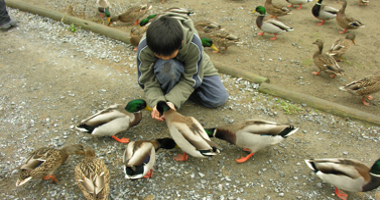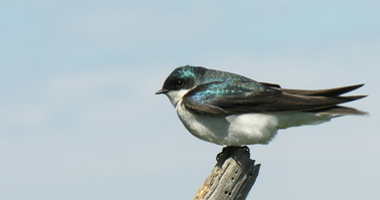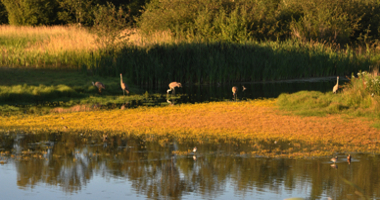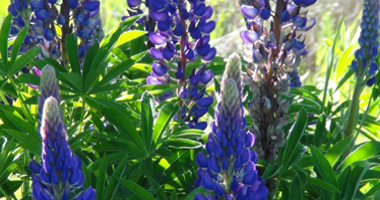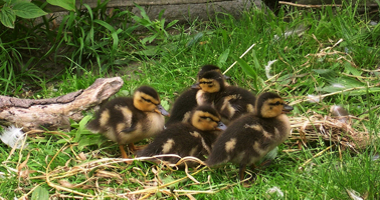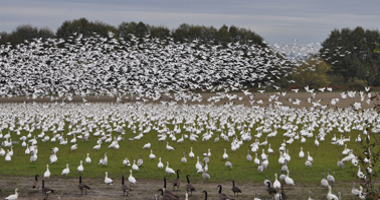Tracking the Wild Geese
In March 2023, Dr. Sean Boyd and Dominic Janus started a research project to track Snow Geese and Canada Geese, using advanced technology neck collars.This project is funded by the British Columbia Waterfowl Society and Environment and Climate Change Canada, with support from the University of British Columbia, and the Washington State Department of Fish and Wildlife.
The neck collars are fitted with solar panels and GPS-GSM technology and can track the movements of individual geese in great detail using GPS (satellite) plus cellular technology to pinpoint their location regularly through the day and night. The tags can indicate their location every 15 minutes and also indicate whether geese are resting, foraging or flying. This is solar powered technology and tags will remain active for many years. In 2016, a few of the Snow Geese that winter here in the Fraser delta were captured on Wrangel Island during nesting season and fitted with these collars. That preliminary study was very informative once the birds were on their wintering areas and is the basis for expanding this research with more birds in this current project.
Map of the fall migration of Snow Goose Canu 09 in 2016.

The primary focus of the project is on the Snow Geese subpopulation that nests on Wrangel Island, Russia, and winters here in the Fraser Delta and across the border in the Skagit estuary in the State of Washington. The project will document the intensity of the foraging of geese in areas where marsh plants are depleted, where their activity overlaps with aircraft activity, their night feeding behavior, and overall intensity of use in different local farm fields where visible impacts of grazing are seen. The telemetry data will also help to identify any new staging areas, movements back and forth between here and the Skagit Estuary, new inland wintering areas, and variations in migratory routes from year to year in response to weather factors. Mid-winter aerial surveys are currently the standard for obtaining a Snow Goose population estimate each year, but flocks move constantly throughout the wintering grounds and sub-populations may have some new locales here or are now taking different migration routes and may be missed in population analyses.
Studies of the plant communities out in the intertidal marshes has been ongoing for years. Key bulrush stands that have supported wintering Snow Geese appear to be in decline, and this current project hopes to monitor bird use and foraging intensity on those target areas and to gain some insight into choices individual birds make while moving around the landscape each day. Collars are also being fitted on Canada Geese, as this species has been seen foraging out in foreshore marshes shared with the Snow Geese in winter, and there are considerable numbers of Canada Geese in those same locations mid-summer when they are flightless due to their annual molt. The origin of these moulting flocks and their feeding patterns on the foreshore as well as local parks and farms is poorly understood.
Progress reports:
Spring 2023, Summer 2023, Fall 2023,
Winter 2024.
Spring 2024 Summer 2024 Fall 2024
Spring 2023 Update
By early April 2023, only a few Snow Goose collars had been successfully installed on birds. Local capture attempts started mid-March and targeted 10 to 12,000 geese using Westham Island and Brunswick Point. The majority of the other wintering flocks had started northwards on their migration, leaving only a few smaller flocks by this time. There were many failed attempts and some goose mortality at first due to Bald Eagle harrassment and predation. Only 4 geese were successfully tracked around the Fraser Delta in early April and only 2 tracked northwards during spring migration when they left the Fraser Delta.
Click on the following link to watch the movements of the four collared Snow Geese in the first week of April.
Tracking four Snow Geese in the Fraser Delta April 1st to 5th, 2023
The figure below is a sample track of one of the four Snow Geese (Female X33) from the 28th of March to the 4th of April. Note the concentration of location data (blue dots) on farms of Westham Island, plus some offshore explorations and use of Brunswick Point lands. According to Sean, “The offshore roosting/resting locations for these geese (and the entire flock) are shown for that week. They flew directly offshore and moved with the currents for several hours in the early morning, and then flew directly back to shore and used notable farm hotspots during the day. Also note there were few foraging points on the foreshore marsh that week, with all foraging seen on farms.”

Spring 2023 migration of Snow Goose X33:
On the 11th of April, Snow Goose X33 left the Fraser Delta and flew 16.5 hours on a non-stop flight of more than 900 km from the Fraser Delta clear across BC to land for a brief rest in Sylvan Lake, just southwest of Edmonton, Alberta. This was an unexpected flight, as most Fraser Delta birds migrate northwards up the coast of BC, Alaska and the Rusian mainland en route to their nesting grounds on Wrangel Island. It was also an unexpected flight for its speed, as the bird primarily followed valleys but was at an altitude of 2850 m as it passed over the Rocky Mountains. Flight speed varied from 22 to 97 km per hour. Unfortunately, once in Alberta, the bird was then tracked to a farm to the east of this and by the 18th of April onwards, it seemed to not be moving on from that area and was assumed to be dead.

Spring migration of Snow Goose X17: Snow Goose X17 departed the Fraser Delta on April 15th, and was tracked up the coast to Alaska in spring until it was out of cell tower range after leaving Anchorage. Stops along this part of the journey: A brief rest in the water by Savary Island; a day or so at the Stikine River estuary: an estuary just south of Yakutat, Alaska; at least 9 days at Controller Bay, AK; Ziegler Bay AK; another 9 days at Cook Inlet, AK; then a brief investigation of the top of glacier near Anchorage. When this bird returns to the Fraser Delta in the fall, all the data stored from its activities in Alaska and Russia and its southward migration will be downloaded.

Details of Snow Goose X17 Migration 2023 as far as Anchorage
Summer 2023 Update
Canada Geese: On July 5 2023, 425 Canada Geese were caught and banded on an marshy island offshore of Alaksen NWA and the Reifel MBS during their flightless (moult) period. Twenty-five geese were selected to wear the neck collars. Between July 5th and 16th, the tracks of these geese showed that, as they gained flight ability, they began to range farther afield, moving to Richmond, the Sanctuary and other nearby areas like Brunswick Point. We started to see these collared birds at the Sanctuary by July 29th, with up to a dozen or so present until late August. Click on the following link to see how the geese started moving from the capture point to moving around the estuary between July 5th and 16th as they finished their moult and regained flight capability. Canada Goose movements July 2023
In early August, some Canadas disappeared off the Delta search screen and were found transmitting from south of the border in Washington State. A few weeks later, 5 others had migrated south to Oregon and one goose traveled as far as Fortuna in northern California. The following image shows the path Canada Goose C22 took south, reaching Fortuna in only 5 days.

Here in the Fraser Delta, in August, two collars were retrieved from marshes offshore of the Sanctuary after the collars indicated the birds had died (likely predated). When the Canada Goose hunting season opened in September, 10 of the collared geese were taken by hunters (8 on/near Westham Island and 2 in WA State).
Fall 2023 Update
Canada Geese: Dominic Janus reports " Of the initial 25 tagged geese, 13 are still alive: 8 in Delta; spending most of their time around Westham Island and South Richmond; 1 in Washington southwest of Chehalis; 3 in Oregon ( one on the Willamette River and two on the Umpqua River ); 1 in Northern California in the Eel River Delta. Of the geese that didn’t make it, 2 died of unknown causeslikely predation) in July and August near Westham Island, 9 were shot during the early September hunting season; 8 in the Fraser Delta, and 1 in Washington near Castle Rock, and 11 stopped transmitting data on November 7 (presumably hunted or predated)."
We have learned some interesting things about the habitat use, movements, and harvest rates of these birds so far. Some moulting Canada Geese at Westham Island appear to be short-distance migrants from the United States (WA, OR, CA). This is known as a moult-migration, and is commonly documented in resident/introduced Canada Geese residing in areas that may not have ideal moulting habitat. The Fraser Delta is a perfect moulting area given its abundant marsh vegetation, open water, and low numbers of predators in summer (especially eagles). Hundreds of Canada Geese are hunted here in the Fraser Delta during the early September hunting season. This short 9-day period is the first open waterfowl season of the year and is designed specifically to target local Canada Geese; the harvest of Canada Geese in the Fraser Delta after that decreases during the three open seasons between October-March, as birds then spend most of their time in areas closed to hunting. Although many birds didn't survive the early hunting season, most of the collars did! This means that many collars can be re-used in the future."
Snow Geese: Snow Goose X17 has returned from Wrangel Island, Russia. This adult male goose was tracked up the coast northwards to Alaska in spring until it was out of cell tower range near Anchorage. When it arrived back in the Fraser Delta on October 5th, 2023, all the data on its spring route, its summer season on Wrangel Island and its southwards migration were all downloaded. We are hoping that X17 makes it through the winter here in the Fraser Delta so we get a year-round picture of its movements. This fall and winter, more collars will be deployed.

Snow Goose X17 remained mainly in Delta and Richmond and Richmond foreshore and farm habitats since its arrival in October to the end of December (see tracks below). This is an adult male, and from the data recorded on Wrangel Island, the bird is assumed to have not nested, and to not be traveling with young of the year.

Winter 2024 Update
There are now some more Snow Geese wearing collars, not just X17. Sean Boyd reports "We deployed our remaining 20 collars on Snow Geese in the Skagit on 1 Feb 2024. We caught 78 geese total with a rocket net (see photo). Matt Wilson of Washington Department of Fish and Wildlife was a huge help as was Maynard Axelson and some folks from the Stillaguamish Tribe. Incidentally, the % young this year is close to 1%, so this is a second consecutive breeding failure for the Wrangel Island population. Also, there are very few Snow Geese in the Skagit area right now, and nobody knows where the rest are hanging out. One tagged goose has already been predated, and the tag was retrieved this morning. The tagged geese are already dispersing within the Skagit delta, and I suspect that some will be moving to the Fraser delta soon, and eventually start northwards to Wrangel Island."

Spring 2024 Update
Tracking the start of spring migrations of Snow geese:
Researchers monitored the collared Snow Geese through variable winter weather and hunting seasons from January to March. Of the Snow Geese collared in 2023 and 2024, many were shot or predated by the end of March when signs of spring migration were expected. Snow Goose X17 survived the winter in Delta and is the only remaining collared live bird from the spring 2023 efforts. This bird remained in Delta all winter from its arrival in early October from Wrangel Island.
In the Skagit estuary in Washington State, of the 20 geese collared in early February, only 12 birds survived to early March. Some of these birds moved to Lynden, a small community across the border from Aldergrove. One (X34) was reported dead there in late March, another (X25) stayed a while and went back to the Skagit Estuary. X31 remained in Lynden all of March.
From this point on, five of the Skagit collared birds made some surprising moves eastward. On March 27th, X21 and X25 veered east from the Skagit and after less than a day's non-stop flight, they ended up in Alberta and/o the north part of nearby Montana. On April 2nd, Snow Goose X11 flew to Lynden then went east almost as far as Saskatchewan, turning back into central Alberta only when it reached Wainright. On April 7th, Goose X31 did a trial run from Lynden up the Fraser Valley to Cheam Lake (Popkum), then returned to Lynden. A few days later, on April 10th, it flew eastward all the way to Alberta. Snow Goose X27 made a trial flight northeast of the Skagit following a tributary of the Nootsack River. Within a day, it also was on its way to Alberta, flying high over the Rockies. The birds flying to Alberta and then northwards are not following the usual BC coastal route assumed to have been taken by Fraser-Skagit Snow Geese, so these birds are of high interest. The details of the eastward migration are slightly different for each of the birds. Last spring Snow Goose X33 flew to Alberta but died within a few weeks, and was assumed to be an an anomaly. The Alberta route northwards overlaps with other continental populations of Snow Geese. In the meantime, the other Skagit Snow Geese have moved northwards following the BC coastline.
Snow Goose X17, collared last year, remained in Delta and Richmond all winter. On April 9th, it made a test flight north from Westham Island, Delta, over the Vancouver International Airport to downtown Vancouver's English Bay, then turned around and went back to Westham Island. Radar screens at the airport picked up the same flights north and south that day of other Snow Geese. This seems to have been a trial flight and the signal for the departure of this bird and its associated flock northwards, as the next day it was tracked passing Bella Coola. We have noted these "trial flights" in nearly all of the Snow Geese just before they begin their migration flights northwards.

Test Flight (north-south yellow line) of Snow Goose X17 from Westham Island, over Richmond and Vancouver Airport to English Bay and back to Westham Island 9th April 2024.
As of April 22nd, the thirteen 2024 track Snow Geese are moving northwards. Following the coast northwards are X13, X16, X23, X24, X29, X32 and X37 from the Skagit and X17 from the Fraser Delta. In Alberta, X11, X21, X25, X27, and X31 are all moving north through Alaberta after crossing eastwards from the Skagit.
Summer 2024 update

This summer, 7 refurbished satellite telemetry collars were re-deployed on flightless Canada Geese that were captured in early July off Westham Island. Like last year, one interesting finding from tracking these geese is the late summer movement of some to overwintering areas in Washington, Oregon and even California.
Fall 2024 Update
This spring, 13 Snow Geese were tracked as they headed north to their nesting grounds on Wrangel Island, Russia. Tracking stopped when the geese moved into remote northern locations out of cell tower range. It was not until late September that these marked geese moved south and were detected again as they “checked in”. As of mid-October, 10 of the 13 geese have been located, with their northern migration routes, movements around Wrangel Island, and their southern migration routes mapped.
We are still waiting for the one Fraser Delta goose X17 and two other Skagit geese to show up on the tracking system. Fraser bird X17 was last recorded at the Stikine estuary on his way north this spring. The other two were last reorded at Anchorage Alaska on the northern journey.
As expected, 9 of the 10 other tracked geese returned to the Skagit delta this fall. Some of these geese followed the coast during their north and south migrations (see X29 map), but 5 used a spring route north through Alberta and a fall route south along the coast, with some flying across a large part of the Pacific Ocean. The 10th bird is still near Brooks, Alberta and is the one bird that took a route through Alberta for both north and south migration (see X21 map).
Each of the routes represents the spring and fall migration patterns of 10s to 100s of Snow Geese as they tend to fly in small, tight flocks.

X21Routes in 2024

X29 Routes in 2024
In November, Snow Goose X31 moved from the Sakgit to the small town of Lynden just south of Aldergrove and across into Washington State. The movements of this bird are very interesting, as they coincide with large flocks of Snow Geese observed out in Abbotsford and Chilliwack, so the bird might be part of these flocks and may be frequently returning across the border to Lynden.

Winter 2025 Update
Throughout most of the winter, the collared Snow Geese almost all stayed throughout the Skagit Valley and Northern Washington. In early March, X31 was the first and only of the collard Geese to move from the Skagit up to Linden where it spent lots of time in the fall and early winter. It is likley moving Northward to get ready for the trip back up to Wrangle Island for the nesting season.








